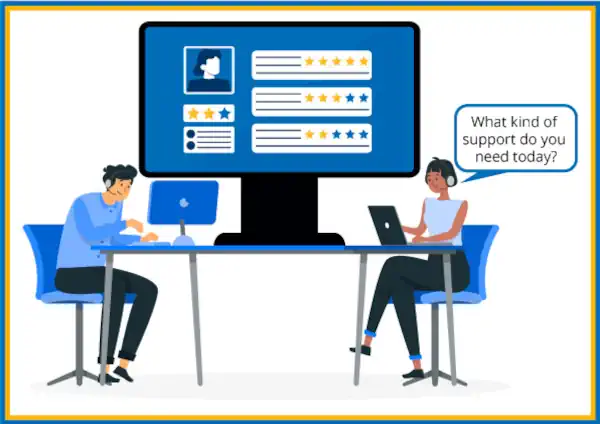Efficiency and automation dominate the call center conversation—but it’s empathy that truly sets customer experiences apart. Whether an agent is handling a billing error, a product complaint, or a frustrated caller, how they make the customer feel can be the difference between a loyal advocate and a lost account. And while empathy may be expressed during frontline interactions, its roots trace directly back to leadership.
You can’t build an empathetic customer experience if your internal culture isn’t modeled around the same principles. It’s not enough to train agents in soft skills or provide them with a list of empathy statements. For real transformation to take place, leaders must intentionally foster a workplace environment where empathy is understood, practiced, and valued.
At SQM Group, we’ve seen firsthand how empathy—when embedded in both leadership behaviors and coaching frameworks—leads to measurable improvements in First Call Resolution (FCR), Customer Satisfaction (CSAT), and agent engagement. In this blog, we’ll explore why empathetic leadership is essential, how to build a culture that reflects it, and what steps call center leaders can take to lead by example.
Why Does Empathy Matter Now More Than Ever?
Customer expectations have evolved. People no longer just want their issues resolved—they want to feel heard, respected, and understood. In a world where technology can solve problems faster than ever, what truly builds trust and loyalty is human connection. That’s why empathy has become a critical differentiator in customer service.
Empathy in the call center isn’t about agreeing with the customer or fixing everything in a single call. It’s about acknowledging their emotions, validating their concerns, and responding with genuine understanding. A simple “I can hear how frustrating that’s been for you” can de-escalate tension, build rapport, and open the door to a more productive conversation.
But the value of empathy goes beyond customer sentiment. It directly impacts the bottom line. Research by SQM Group shows that agents who demonstrate empathy are more likely to achieve FCR, a key driver of customer loyalty and operational efficiency. When customers feel emotionally supported, they’re less likely to call back, escalate the issue, or churn.
Empathy also improves the employee experience. When agents are encouraged to connect authentically with callers—and are supported by leaders who do the same for them—they report higher job satisfaction, lower burnout, and greater engagement. In short, empathy isn’t just good for customers; it’s good for business.
Yet despite its importance, empathy is often treated as a soft, optional skill rather than a leadership imperative. The result? A disconnect between what companies say they value and what’s actually practiced on the floor. That’s why building an empathetic call center culture must start from the top.
How Can Leaders Build and Model a Culture of Empathy?
In many call centers, empathy is approached as a checkbox item—built into scripts, added to scorecards, and reinforced during onboarding. While empathy statements can be helpful prompts (“I understand how frustrating that must be”), they’re not a substitute for authentic connection. When overused or delivered robotically, they can do more harm than good—coming across as disingenuous or performative.
True empathy isn’t a line in a script—it’s a mindset that must be modeled by leadership and supported by culture. When agents see their team leads, supervisors, and senior managers practicing empathy in day-to-day interactions—listening actively, showing patience, offering support—they’re more likely to internalize those behaviors and reflect them in customer conversations.
This starts with how leaders interact with their own teams. Do managers take the time to understand what’s going on in an agent’s life that may be affecting performance? Do they listen without rushing to fix or criticize? Are they open about challenges and transparent about decision-making? These moments of leadership empathy build trust and psychological safety, creating a workplace where emotional intelligence can thrive.
Culture cascades from the top. If leaders are modeling empathy in coaching sessions, team meetings, and one-on-one conversations, agents learn that empathy is more than just a buzzword—it’s a value. And values aren’t taught; they’re demonstrated.
If you want empathy to be part of your call center culture, it has to come from the top. You can’t just tell agents to be more empathetic and expect it to stick. Leaders—supervisors, team leads, QA managers, and senior staff—need to show what empathy looks like every day. That’s how it becomes part of the team’s mindset, not just part of a script.
Here’s how leaders can shape and grow an empathetic culture through their everyday actions, coaching habits, and team development—plus some unique ways to make it real.
1. Lead by Example in Everyday Interactions
Culture is shaped more by what leaders do than by what they say. If a manager is patient, respectful, and calm during a tough team meeting, that behavior trickles down. If they take time to listen to agents instead of rushing through 1:1s, agents learn that listening matters.
For example, a team lead who regularly checks in by asking, “What kind of support do you need today?” sets a very different tone than one who only asks, “Did you hit your numbers?”
Even small things—like saying thank you after a tough call or recognizing effort when performance is slipping—can show that empathy is valued, not just outcomes.

2. Create Time and Space for Human Conversations
In fast-paced environments, it’s easy to skip personal connection. But empathy grows in conversations that aren’t just about stats.
Try holding weekly 10-minute team check-ins to talk about how the work is feeling—not just how it’s performing. Encourage leaders to ask questions like:
- “What’s something that made a call tough this week?”
- “Where do you feel stuck?”
- “How can we support each other more?”
You can also start “Voice of the Agent” huddles or casual roundtables, where agents give feedback on policies, processes, and leadership behavior. The key: Listen without defending. Write down what you hear. Show you care by following up.

3. Recognize and Celebrate Empathy in Action
It’s common to reward productivity—like low average handle time or high sales—but if you want agents to be empathetic, you have to reward it.
Ideas to make empathy visible:
- Share stories of agents who turned around difficult situations through listening and kindness.
- Add a monthly “Empathy MVP” award based on peer or customer feedback.
- Highlight empathy-focused customer survey comments in team emails or dashboards.
Even a quick message or shout-out in a team meeting can boost morale and show that emotional intelligence is just as important as speed.

4. Build Flexibility into Coaching and Policies
Sometimes, the way a system is designed makes it hard for agents to act with empathy. If they’re rushing to meet call targets or forced to say “no” because of rigid policies, customers will feel that disconnect.
Empathetic leadership means looking at policies through a human lens:
- Give agents permission to take an extra few minutes on emotionally heavy calls.
- Adjust scorecards to balance speed with quality of interaction.
- Review scripts to make room for more natural, caring responses.
- Let agents offer small gestures (like a follow-up email or a waived fee) when appropriate.

5. Train Leaders to Coach with Empathy
Empathy isn’t just for agents. Leaders need to learn how to give feedback with care, especially when performance issues arise.
Simple ways to build leadership empathy:
- Use role-playing to practice coaching after emotionally difficult calls.
- Teach managers to ask why before judging behavior—“Is something going on outside of work?” can change the whole tone of a conversation.
- Invite mental health speakers or peer mentors to talk about stress, burnout, and compassion in the workplace.
For example, instead of saying “You need to improve your tone,” a leader might say, “That call sounded tense—what was happening for you there?” This opens the door to dialogue, not defensiveness.

6. Walk in the Agent’s Shoes
Finally, one of the most powerful things leaders can do is experience the job firsthand. Ask leaders to sit in on calls, handle mock scenarios, or shadow agents regularly.
When they feel what it’s like to juggle a script, handle a frustrated customer, and hit performance targets all at once, their empathy deepens—and their decisions become more grounded.
When leaders consistently show empathy, support emotional growth, and remove the barriers that prevent human connection, a culture of empathy becomes more than a goal—it becomes the norm. And when that happens, both your agents and your customers feel the difference.

